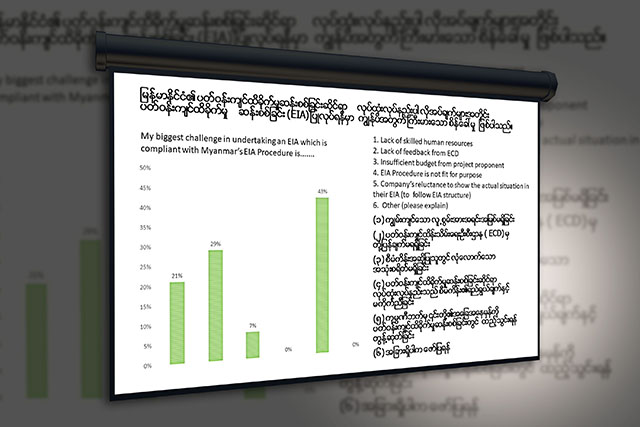Our Biggest Challenge as Consultants is Companies Refusing to Admit Projects Could Have Negative Impacts

MCRB, together with the Ministry of Environment and Natural Resources Conservation (MONREC) and Vermont Law School, with support from Heinrich Boll Foundation, held a workshop for local Environmental Impact Assessment Consultants with a focus on assessing social impacts – i.e. impacts on people - and the value of public participation and consultation in identifying these.
The workshop was attended by over 40 consultants from over 20 mostly local EIA consultancies. It was an opportunity not only to build capacity, but also for MONREC to give feedback to consultants and vice versa on the first two years of operation of the EIA Myanmar Procedure.
Htin Aung Kyaw, Assistant Director of the Environmental Conservation Department in MONREC updated the consultants on progress with the transitional consultant registration scheme (currently free of charge), and the numbers of incoming reports. As of 31 October, ECD had received 272 Environmental Impact Assessments (EIA), 384 Initial Environmental Examinations (IEE), 1856 Environmental Management plans (EMP), mostly for existing mines, and mostly submitted in 2016-2017, giving a total of 2512 Projects which had submitted documents. Concerning transitional registration, 37 organisations and 142 consultants had been registered by July 2017, with more undergoing screening.
ECD highlighted major procedural and substantive weaknesses that they had regularly observed in the Impact Assessment documentation submitted to the department. These included: failure to systematically follow the steps in the EIA Procedure and provide all the requested documentation; failure to engage relevant line ministries and state/region governments; lack of clarity about the project in the submitted Project Proposal; failure of Project Proponents to submit documents with a Letter of Endorsement which undertakes responsibility for their accuracy and compliance with the EIA Procedure and agreed Terms of Reference; failure to provide follow-up contact details; failure to clearly identify policies, legal standards and commitments which will be adhered to; lack of maps, or detail of land use; lack of schedule for construction and operation; lack of meaningful alternatives analysis; lack of environmental baseline data or information about how it has been obtained; lack of information about the methodology for assessing adverse impacts and selecting mitigation measures, or information about the technology to be used in mitigation; lack of information about residual and cumulative impacts.
Weaknesses in Environmental Management Plans included lack of mitigation measures to address Significant Impacts identified in the EIA; lack of information about who would implement the mitigation actions of the EMP; lack of timeframe or estimated budget for actions in the EMP; absence of a clear register of commitments in the EMP; lack of information about monitoring, for example parameters and monitoring frequency.
Concerning public participation, there was a lack of information about methodology adopted for consultations; and lack of information about the consultations themselves, the outcomes and how the Project Proponent had responded or planned to respond to issues raised. There was also little detail about: consultations with Project Affected People (PAP); approach to disclosure including use of websites and local media; and little inclusion of relevant reference documents.
The EIA consultants were polled on their biggest challenges in submitting reports that met the required standard. The main problem was the reluctance of the Project Proponent company to include an accurate assessment of potential environmental and social impacts in the EIA report (43%). Consultants also said that lack of feedback from ECD (29%) and lack of skilled human resources (21%) were major challenges with 7% identifying Project Proponents were unwilling to provide an adequate budget from project proponent. The EIA Procedure per se was not identified as a problem by any consultant.
Vicky Bowman spoke about how to assess ‘social impacts’ which are an integral part of the Myanmar EIA. She emphasised that social impacts means any impact on people, and are therefore intimately linked to impacts on the environment, culture, governance etc. The best way to assess social impacts and identify mitigation measures was therefore to consult people, particularly, but not exclusively, project affected people. For that reason, effective consultation and public participation was essential for an effective EIA and EMP, as well as being a legal requirement in the EIA Procedure.
The importance of public participation was reinforced by polling in the workshop of consultants on the main sources of community grievance about projects. The main complaint was lack of transparency and consultation of local communities (44%). Second most common complaint was loss of land without sufficient compensation (31%), with impacts of pollution impact on health or livelihoods (13%), lack of employment opportunities for local people (6%) and poor working conditions (6%) also mentioned.
Matthew Baird of Vermont Law School outlined the draft Public Participation guidelines which had been drawn up through a multi-stakeholder consultation and were now awaiting formal adoption by MONREC. Drawing on the relevant texts of these draft guidelines, Hnin Wut Yee and Aung Kyaw Soe of MCRB highlighted specific issues around consultation of ethnic minorities, and in conflict zones, and also models for effective operational grievance mechanisms.
MCRB and Vermont Law School plan to conduct follow up training with EIA consultants and others in future, including civil society organisations, in collaboration with MONREC, and other development partners.
အထက်ပါအကြောင်းအရာနှင့်ပတ်သတ်၍ ဆက်လက်ဖတ်ရှုလိုပါက
- Building Environmental Legal Advocacy Skills for Civil Society Leaders
- Investors Need to Identify their Impacts on Myanmar’s Biodiversity and Ecosystems Early On, to Avoid Cost and Conflict Later
- Building Understanding of EIA and Responsible Business for Civil Society Groups in Southern and Eastern Shan State
- Working with Community Groups in Shan State on Responsible Business and EIA
- Join MCRB and Thant Myanmar in the Battle to Beat Plastic Pollution
 English
English မြန်မာ
မြန်မာ မြန်မာ (unicode)
မြန်မာ (unicode)










